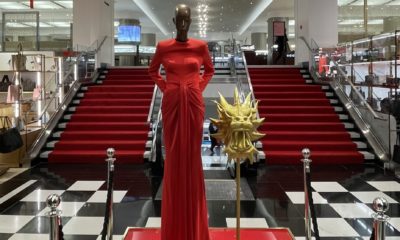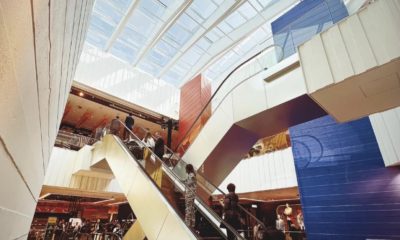THE GREAT MERCHANT princes of the early 1900s incorporated the 3 “A’s” of enticement to attract people into their stores: Architecture, Advertising and Art.
Grand architectural edifices celebrated the newfound department stores at the turn of the last century in cities across the world, from Chicago and New York to London and Berlin. In 1904, John Wanamaker famously said of his store in Philadelphia, “The time to advertise is all the time.” And as the Gimbel brothers opened stores in the mid-1910s in New York, Cincinnati, Cleveland and Philadelphia, they proudly exhibited the works of Cézanne, Picasso and Braque in their new establishments.
Additionally, the works of painters ranging from the French impressionists to Georgia O’Keefe and Boardman Robinson, have notably graced the halls of retail stores from Paris to Pittsburg. In more contemporary times, a stroll down pre-pandemic Fifth Avenue would reveal the work of German-American illustrator Joseph Christian Leyendecker in Saks Fifth Avenue windows, or a Harry Bertoia sculpture in The North Face flagship store.
Retailers are navigating the unchartered waters of the post-pandemic world, and the role and importance of art in the retail environment is becoming even more important than ever before. The term “experiential retail” dominated the discourse before Covid and we continue to hear those words today.
It’s hardly a new concept; in fact, it goes back to the days of Wanamaker and Harry Gordon Selfridge who strategically developed the art of experiential merchandising by employing the technologies of the day. They knew back then that a store must be more than merely a place to buy things.
A fourth “A” of enticement in those early days was air conditioning, a new technology at the time. In the hot summer months, Henry Siegel, the founder of what was the largest store in the world, the Siegel and Cooper department store, knew that his sprawling establishment offered a degree of escapism from the brutally hot summer sidewalks of New York. Today, after years of political upheaval, social unrest, geopolitical struggles and a brutal and seemingly relentless pandemic, people are yearning to once again, get out of the heat.
Advertisement
Art often documents the times, and commenting on the events of the day whether good or bad, it also has the innate ability to transport the viewer to another place, perhaps even to another state of mind. As retailers endeavor to create experiential shopping concepts, it should be noted that art in the retail environment, whether brick-and-mortar or digital, elevates the customer experience while taking them perhaps to a place that they’ve dreamed of and even longed for.
Mark Cho, a Co-Founder of The Armoury, an international men’s haberdashery in Hong Kong, totally understands this concept. The first Armoury store opened in 2010, was based on a vision of service, craftsmanship and soul in the men’s clothing and accessories sector. After successfully launching their first New York based store in TRIBECA, Cho decided to expand his reach to the Upper East Side in 2019.
There was an empty store on Madison Avenue and East 69th Street previously occupied by the venerable houses of Gucci and Balenziaga. Cho, long wanting a location on the Upper East Side, signed a one-year lease for the location in what was to be a pop-up store. Now, having survived the perils of the pandemic, the store stands as a custom and bespoke boutique in the upscale New York neighborhood. Cho thought that the existing conditions in the space were ideal for the implementation of a concept that was near and dear to his heart. He wanted to integrate art into the retail environment. He long held to the theory that a retail establishment should do more than just sell, it should also teach and inform. In addition to telling the unique stories of the world class artisans who define bespoke tailoring, Cho wanted to broaden customer engagement though the universal language of art.
The Madison Avenue store, called The Armoury Westbury, is the retailer’s most experimental space to date. “It is a pop-up space that had to work within the constraints of the previous tenants’ fit-out and so we tried to add our style onto a pre-existing design,” says Cho. “It was a very interesting challenge and I’m reasonably happy with how it turned out.”
The store had a second level that was ideal for fitting and tailoring, offering a relaxed environment for exceptional personal customer interaction – the space was also ideal for a salon for the exhibition of fine art. In addition, a perimeter wall on the second level had an existing shelving system perfectly positioned for the display and sale of art-related books and associated literature. Cho’s vision was to not only curate the finest selection of the best modern classic menswear, but also to curate an ongoing cultural experience. To help facilitate his vision, Cho called upon long-time friend Miyako Yoshinaga, the director of the Miyako Yoshinaga Gallery on East 64th Street, to curate a rotating schedule of art installations in The Armoury’s second floor salon.
One of the first artists in Yoshinaga’s calendar of exhibitions at The Armoury was Ellen Fisch, Brooklyn born architectural, landscape and still life photographer. Yoshinaga knew of Fisch’s work from an exhibition at the iconic Coffee House, the venerable New York social club. “I wanted to show still life images at the Armoury,” says Yoshinaga. “I thought the universal appeal of this genre, together with Ellen’s high-quality imagery, would be perfect for the space.”
Advertisement
Fisch’s still life collection evokes visions of Cézanne as she “paints” every frame with a natural light that emphasizes shape and form. Each composition captures a moment in time through the placement of objects and viewpoints, juxtaposing the traditional experience and the hard-edged beauty of domestic life.
“My photographs combine reality, imagination and new experiences with my passion to share my visions,” says Fisch.
The exhibition, which ran from February 8 to March 26 of this year, featured 12 etherial still life compositions defined by a beautiful delicacy of line, texture and light. Fisch references the simple complexities of Albrecht Dürer as inspiration for her own work, most notably his studies of pillowcases. “I was moved to tears when seeing this work. The genius of Dürer expressed through the basic form transformed into brilliant yet simple (in itself highly complex) subjects.”
Another source of inspiration for Fisch was the celebrated 19th-century French painter Henri Faintain-Latour, whose exquisite still life paintings of flowers expressed a detailed elegance through light and soft gradations of color.
Fisch’s exploration of still-life photography was further inspired in 2020 by the isolating effects of the pandemic. While confined at home, she began a cleanup and editing of the many things that accumulated over the years. As she rummaged through, she discovered a cornucopia of objects such as bowls, jars and silver trays that were either forgotten or ignored over the course of time. With a newfound interest in their shapes and textures, she considered them as vehicles for self expression. As northern light penetrated through her studio window, she marveled at the way each piece took on new life. Every object reflecting light and casting shadows, became a powerful statement referencing the essential characteristics of the human experience.
In her latest series of atmospheric photographs presented at The Armoury, Fisch created arrangements of seasonal flowers and fruits whose ephemeral qualities harmonized with the timeless nature of the collected objects. “Each work embraces a distinctive personality in the combination of shapes, lines, compositions, and shades depending on the light at the time of day,” said Fisch.
Advertisement
The artist shot more than 400 frames of each arrangement, painstakingly selecting the final image in what she called a labor of love.
Any successful retail strategy must be built upon a dynamic connection between science and art. The science of retail begins with a methodical study of the constructs that drive human behavior, and an analysis of the data that measures wants, needs and desires. The art of retail begins with a creative concept sparked by imagination and driven by the movement of emotion.
“Our philosophy for retail is to create spaces that are enjoyable to dwell in,” says Cho. “Our benchmark is that the shop should feel like a library that you can drink in. It should not be overtly commercial and it should not be intimidating. We prefer to use dense arrangements of product, a quiet environment and a touch of home furnishing to make the space feel as cared for and welcoming as possible.”
The collaboration between Cho, with his bespoke sensibilities and merchandising acumen; Yoshinaga, and her curatorial sensibilities as demonstrated in her esteemed gallery tucked between Fifth and Madison Avenues; and the aesthetic and creative sensibilities of Fisch, with her inspired photographic compositions; was the perfect confluence of scientific analysis and the structured movement of emotion in pursuance of the art of retail.
Click here to see more of Ellen Fisch’s still lifes.

 Photo Gallery1 week ago
Photo Gallery1 week ago
 Headlines7 days ago
Headlines7 days ago
 Headlines1 week ago
Headlines1 week ago
 Headlines2 weeks ago
Headlines2 weeks ago
 Headlines1 week ago
Headlines1 week ago
 Designer Dozen2 weeks ago
Designer Dozen2 weeks ago
 Designer Dozen5 days ago
Designer Dozen5 days ago
 Headlines7 days ago
Headlines7 days ago





















